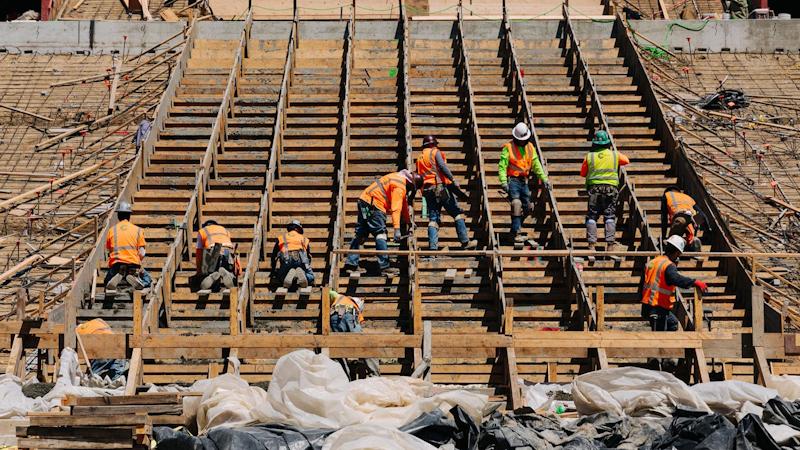Construction work (earthworks, deconstruction, drilling, etc.) generates large volumes of waste for which the question of management arises. The building sector produces millions of tons of waste per year in California, including:
- 45% comes from demolition
- 40% of renovation
- 15% of new construction
Despite increasingly advanced traceability of elimination as well as the implementation of a defined protocol, today more than 80,000 tons of waste end up in illegal landfills in California. These issues represent significant ecological issues and threaten the sustainability of California. They also lead to a process of reflection for better management of construction site waste.
Responsibility
To begin with, each person producing construction site waste is responsible for it, from its emission to its final elimination or recovery. A specialized third-party company can also take care of this task.
However, manufacturers, distributors and importers are responsible for the financial management of future waste generated by their products. To do this, they can take back products in the form of waste free of charge (and under certain conditions). This, in order to treat them properly, by integrating a cost relating to this action into the initial selling price of the product: polluter pays principle.
The different methods of waste treatment
Generally speaking, there are several methods for waste disposal today:
- Incineration which is the most widespread method and which can also be the subject of energy recovery
- Recycling
- Reuse
- Recovery of materials, such as composting or methanization for example
- Prevention or reduction at source. The best way to avoid making waste starts above all by reducing production and therefore consumption
- Burial
The different types of waste
There are three main categories of waste. Inert waste, non-inert hazardous waste and non-inert non-hazardous waste.
Inert waste
Constituting the majority of construction site waste (around 76%), inert waste is so-called mineral waste. These can be concrete, ceramics, bricks, natural stones, tiles, glass, etc.
These are non-hazardous, non-biodegradable wastes that do not decompose. They retain their physicochemical properties when stored. They are taken care of by recycling companies or Inert Waste Storage Facilities (ISDI).
This waste can often be reused in the construction industry. For example, natural stones and concrete products can be reduced into aggregates. They can then replace natural aggregates in structural work. Likewise, we can use existing coatings to make new coatings, etc.
Non-inert waste
Non-inert waste is divided into 2 categories:
Non-hazardous waste, which represents 21% of waste from the construction sector. This waste is neither corrosive nor explosive. This can be plastic, insulation, plaster, metals, wood, etc. They are non-recyclable and cannot be incinerated. They are stored in Non-Hazardous Waste Storage Facilities. This waste can be recycled energetically (for example wood can be reused in compatible boiler rooms) or materially (for example remelted metals can be useful in metallurgy, plastic once washed and then crushed can become a new raw material).
Hazardous waste, which represents around 3% of waste from the construction sector. This waste contains substances toxic to humans and the environment: asbestos, lead, tar, batteries, paint, etc. This waste and its potential containers must undergo special treatment and must under no circumstances be mixed with other types of waste. seen previously.
This waste must be delivered packaged and clearly identified by specific labeling in accordance with current European regulations. They are stored in Hazardous Waste Storage Facilities and their evacuation is monitored. Traceability is ensured via a Hazardous Waste Monitoring Form which must be completed by each of the stakeholders (producer, collector, transporter, operator of the recipient facility).
Hazardous waste can be recycled but these methods are more expensive. As reported by Frank Nelson, CEO of Glendale Dumpster Rental Bros, coatings made of lead paint can be treated by sandblasting or vitrification in suitable locations, used oils can be regenerated and reused in the cement plant for energy recovery, emptied and decontaminated batteries allow the extraction of lead which will be melted down and recycled.
Waste management on site: what practices should be put in place
To facilitate waste management on the construction site, several principles must be implemented:
- Effective signage. Signage adapted to the construction site in the form of pictograms has been developed by the Building Federation. It is intended to be placed on construction site skips to guide users
- Collection bins. At least 3 in number, one for each type of waste presented above
- Rubble bags. This solution is particularly suitable for small sites (low volume of waste) or in the case of complicated access to the site by trucks and other large vehicles
- Waste collection by dumpster truck
Product Equipment Materials Waste diagnosis, what is it
An Anti-Waste law for California puts in place new measures to improve the management and traceability of waste generated by construction sites.
Since January 1, 2022, this law makes Product Equipment Materials Waste diagnosis mandatory. It makes it possible to clearly identify reusable materials and equipment in the context of building rehabilitation or deconstruction operations. This, under the following conditions:
- If the building has a floor area greater than 1,000 m²
- If the building has in the past housed industrial, agricultural or commercial activities with the manufacture, storage or distribution of substances characterized as dangerous
- If the rehabilitation project includes the demolition or replacement of floors or exterior partitions, exterior joinery, interior partitions, sanitary and plumbing equipment, electrical installations or the heating system
To conclude, the management of construction site waste constitutes a real ecological issue, which is close to our hearts at Florès. It is essential to improve this management and raise awareness among the various players in the construction field. Indeed, it is now urgent to take into account all the negative impacts that the emission of waste can have (harmful consequences on the environment, soil pollution, etc.) and to take into consideration their treatment, or even their reuse for a better environmental context (reducing the extraction of valuable raw resources for example).
